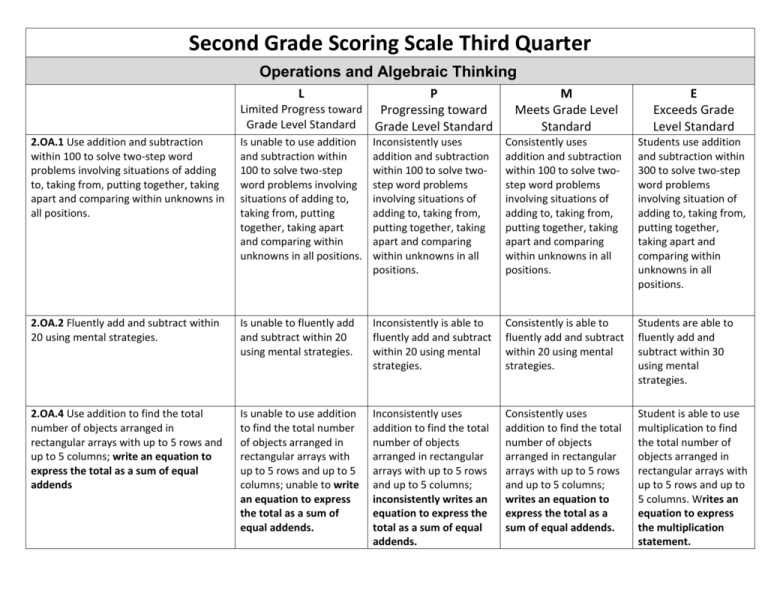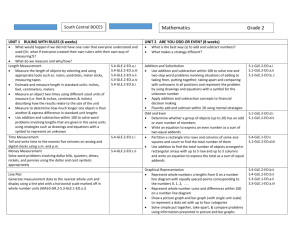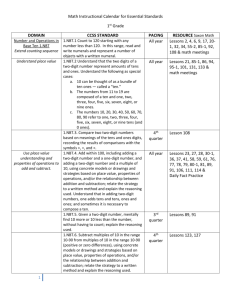equal digits
advertisement

Second Grade Scoring Scale Third Quarter Operations and Algebraic Thinking L P Limited Progress toward Progressing toward Grade Level Standard Grade Level Standard M Meets Grade Level Standard E Exceeds Grade Level Standard 2.OA.1 Use addition and subtraction within 100 to solve two-step word problems involving situations of adding to, taking from, putting together, taking apart and comparing within unknowns in all positions. Is unable to use addition and subtraction within 100 to solve two-step word problems involving situations of adding to, taking from, putting together, taking apart and comparing within unknowns in all positions. Inconsistently uses addition and subtraction within 100 to solve twostep word problems involving situations of adding to, taking from, putting together, taking apart and comparing within unknowns in all positions. Consistently uses addition and subtraction within 100 to solve twostep word problems involving situations of adding to, taking from, putting together, taking apart and comparing within unknowns in all positions. Students use addition and subtraction within 300 to solve two-step word problems involving situation of adding to, taking from, putting together, taking apart and comparing within unknowns in all positions. 2.OA.2 Fluently add and subtract within 20 using mental strategies. Is unable to fluently add and subtract within 20 using mental strategies. Inconsistently is able to fluently add and subtract within 20 using mental strategies. Consistently is able to fluently add and subtract within 20 using mental strategies. Students are able to fluently add and subtract within 30 using mental strategies. 2.OA.4 Use addition to find the total number of objects arranged in rectangular arrays with up to 5 rows and up to 5 columns; write an equation to express the total as a sum of equal addends Is unable to use addition to find the total number of objects arranged in rectangular arrays with up to 5 rows and up to 5 columns; unable to write an equation to express the total as a sum of equal addends. Inconsistently uses addition to find the total number of objects arranged in rectangular arrays with up to 5 rows and up to 5 columns; inconsistently writes an equation to express the total as a sum of equal addends. Consistently uses addition to find the total number of objects arranged in rectangular arrays with up to 5 rows and up to 5 columns; writes an equation to express the total as a sum of equal addends. Student is able to use multiplication to find the total number of objects arranged in rectangular arrays with up to 5 rows and up to 5 columns. Writes an equation to express the multiplication statement. Number and Operations in Base Ten L Limited Progress toward Grade Level Standard P Progressing toward Grade Level Standard M Meets Grade Level Standard E Exceeds Grade Level Standard 2.NBT.1 Understand that the three digits of a three-digit number represent amounts of hundreds, tens, and ones; e.g., 706 equals 7 hundreds, 0 tens, and 6 ones Minimal understanding of the value of digits in a three digit number. With support, student shows some understanding that the three digits of a three-digit number represent amounts of hundreds, tens, and ones. Demonstrates understanding that the three digits of a three-digit number represent amounts of hundreds, tens, and ones. 2.NBT.2 Count within 1000; skipcount by 5s, 10s and 100s Is unable to count within 1000. Does not skip count by 5s and 10s or 100 past 100. Inconsistently counts within 1000. May be able to skip count by 5s or 10s, but not within 1000. Consistently counts within 1000. Student is able to skip-count by 5s, 10s, and 100s within 1000. 2.NBT.3 Read and write numbers to 1000 using base-ten numerals, number names, and expanded form. Is unable to read and write numbers up to 1,000 using base-ten numerals, number names, and expanded form. Inconsistently reads and write numbers up to 1,000 using base-ten numerals, number names, and expanded form. Consistently reads and write numbers up to 1,000 using base-ten numerals, number names, and expanded form. Meets quarterly expectation and demonstrates understanding that the numbers 100, 200, 300, 400, 500, 600, 700, 800, 900 refer to one, two, three, four, five, six, seven, eight, or nine hundreds (and 0 tens and 0 ones). and that “100” is the same amount as 10 groups of ten as well as 100 ones. Student is able to count and skip count within 1000 and is able to explain patterns in skip counting or is able to count by other numbers such as 3s or 4s. Student is able to read and write numbers beyond 1,000 using base-ten numerals, number names, and expanded form. 2.NBT.4 Compare two three-digit numbers based on meanings of the hundreds, tens, and ones digits, using symbols >, = and <, to record the results of comparisons. Is unable to compare two three-digit numbers based on meanings of the hundreds, tens, and ones digits, using >, = and < symbols to record the results of comparisons. Inconsistently is able to compare two three-digit numbers based on meanings of the hundreds, tens, and ones digits, using >, = and < symbols to record the results of comparisons. Consistently is able to compare two three-digit numbers based on meanings of the hundreds, tens, and ones digits, using >, = and < symbols to record the results of comparisons. 2.NBT.5 Fluently add and subtract within 100 using strategies based on place value, properties of operations, and/or the relationship between addition and subtraction. Is unable to fluently add and subtract within 100 using strategies based on place value, properties of operations, and/or the relationship between addition and subtraction. Inconsistently is able to fluently add and subtract within 100 using strategies based on place value, properties of operations, and/or the relationship between addition and subtraction. Consistently is able to fluently add and subtract within 100 using strategies based on place value, properties of operations, and/or the relationship between addition and subtraction. Student is able to compare two four-digit numbers based on meanings of the thousands, hundreds, tens, and ones digits, using >, = and < symbols to record the results of comparisons. Student is able to fluently add and subtract within 300 using strategies based on place value, properties of operations, and/or the relationship between addition and subtraction. 2.NBT.6 Add up to four two-digit numbers using strategies based on place value and properties of operations. Is unable to add up to four two-digit numbers using strategies based on place value and properties of operations. Inconsistently adds up to four two-digit numbers using strategies based on place value and properties of operations. Consistently adds up to four two-digit numbers using strategies based on place value and properties of operations. Student is able to add up to four three-digit numbers using strategies based on place value and properties of operations. 2.NBT.7 Add and subtract within 1000, using concrete models or drawings and strategies based on place value, properties of operations, and/or the relationship between addition and subtraction; relate the strategy to a written method. Understand that in adding or subtracting three-digit numbers, one adds or subtracts hundreds and hundreds, tens and tens, ones and ones; and sometimes it is necessary to compose or decompose tens or hundreds. Student is unable to solve addition and subtraction problems within 1,000. Student has minimal understanding of adding or subtracting groups of 10s and 100s. Inconsistently solves addition and subtraction problems within 1,000. Uses one or two strategies to solve problems but may have errors or occasional mistakes in computation. . Student is unable to explain answers through reasoning. Correctly solves addition and subtraction problems within 1,000. Successfully uses strategies such as place value, properties of operations, compose/decompose hundreds/tens/ones, and/or mentally adds/subtracts 10s and 100s. Explanations are logical, accurate and illustrate strategies used. Student meets quarterly expectation and is able to argue multiple methods of solving the same problem. Student can design and illustrate his or her own word problem and solve. 2.NBT.8 Mentally add 10 or 100 to a given number 100–900, and mentally subtract 10 or 100 from a given number 100–900. Is unable to mentally add 100 to a given number 100-900, and mentally subtract 100 from a given number 100-900. Inconsistently is able to mentally add 100 to a given number 100-900, and mentally subtract 100 from a given number 100900. Consistently is able to mentally add 100 to a given number 100-900, and mentally subtract 100 from a given number 100900. Student is able to mentally add 100 to a given number beyond 900, and mentally subtract 100 from a given number beyond 900. 2.NBT.9 Explain why addition and subtraction strategies work, using place value and the properties of operations. Is unable to explain why addition and subtraction strategies work, using place value and the properties of operations. Inconsistently is able to explain why addition and subtraction strategies work, using place value and the properties of operations. Consistently is able to explain why addition and subtraction strategies work, using place value and the properties of operations. Example: 23+14 “I have two tens and another ten which is 3 tens or 30. I have 3 ones and 4 more ones. I have 30+7 = 37.” Student is able to explain the addition and subtraction strategies in multiple ways and uses these strategies easily. Measurement and Data L Limited Progress toward Grade Level Standard P Progressing toward Grade Level Standard M Meets Grade Level Standard E Exceeds Grade Level Standard 2.MD.6 Represent whole numbers as lengths from 0 on a number line diagram with equally spaced points corresponding to the numbers 0, 1, 2 …, and represent whole-number sums and differences within 50 on a number line diagram Unable to create a number line with evenly spaced points and does not understand how to appropriately use this to represent or find sums and differences. Able to create a number line with evenly spaced points, but does not understand how to appropriately use this to represent or find sums and differences. Consistently creates number lines with evenly spaced points corresponding to the numbers to solve addition and subtraction problems to 50. Recognizes the similarities between a number line and a ruler. Student uses a number line to solve addition and subtraction problems by creating a number line to count on or count back up to 100. 2.MD.7 Tell and write time from analog and digital clocks to the nearest five minutes, using a.m. and p.m. Is unable to tell and write time from analog and digital clocks to the nearest five minutes, using a.m. and p.m. Inconsistently is able to tell and write time from analog and digital to the nearest five minutes, using a.m. and p.m. May be able to tell time to the half hour. Consistently is able to tell and write time from analog and digital clocks to the nearest five minutes, using a.m. and p.m. Student is able to tell and write time from analog and digital clocks to the nearest five minutes, using a.m. and p.m. Student is able to tell and write time from analog and digital clocks to the nearest five minutes, using a.m. and p.m. 2.MD.8 Solve word problems involving dollar bills and coins using the dollar and cent sign appropriately. E.g. If you have 2 dimes and 3 pennies, how many cents do you have? Is unable to solve word problems involving dollar bills and coins using the dollar and cent sign appropriately. appropriately. E.g. Making change; $1.25 etc. Inconsistently solves word problems involving dollar bills and coins using the dollar and cent sign appropriately. Consistently solves word problems involving dollar bills and coins using the dollar and cent sign appropriately. Student is able to solve word problems involving dollar bills and coins using the dollar sign, cent sign and decimal sign appropriately. E.g. Making change; $1.25 etc. Describe shares using the words halves, thirds, half of, a third of, etc., and describe the whole as two halves, three thirds, four fourths. Recognize that equal shares of identical wholes need not have the same shape. Consistently partitions circles and rectangles into two, three, or four equal shares, describes the shares using the words halves, thirds, half of, a third of, etc., and describe the whole as two halves, three thirds, four fourths. Recognizes that equal shares of identical wholes need not have the same shape. Geometry 2.G.3 Partition circles and rectangles into two, three, or four equal shares, describe the shares using the words halves, thirds, half of, a third of, etc., and describe the whole as two halves, three thirds, four fourths. Recognize that equal shares of identical wholes need not have the same shape. Unable to describe the shares using the words halves, thirds, half of, a third of, etc., and describe the whole as two halves, three thirds, four fourths. Does not recognize that equal shares of identical wholes need not have the same shape. Inconsistently describes the shares using the words halves, thirds, half of, a third of, etc., and describe the whole as two halves, three thirds, four fourths. Inconsistently recognizes that equal shares of identical wholes need not have the same shape.







